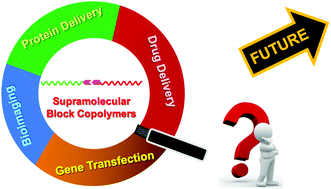Recent advances in supramolecular block copolymers for biomedical applications
Abstract
Supramolecular block copolymers (SBCs) have received considerable interest in polymer chemistry, materials science, biomedical engineering and nanotechnology owing to their unique structural and functional advantages, such as low cytotoxicity, outstanding biodegradability, smart environmental responsiveness, and so forth. SBCs comprise two or more different homopolymer subunits linked by noncovalent bonds, and these polymers, in particular, combine the dynamically reversible nature of supramolecular polymers with the hierarchical microphase-separated structures of block polymers. A rapidly increasing number of publications on the synthesis and applications of SBCs have been reported in recent years; however, a systematic summary of the design, synthesis, properties and applications of SBCs has not been published. To this end, this review provides a brief overview of the recent advances in SBCs and describes the synthesis strategies, properties and functions, and their widespread applications in drug delivery, gene delivery, protein delivery, bioimaging and so on. In this review, we aim to elucidate the general concepts and structure–property relationships of SBCs, as well as their practical bioapplications, shedding further valuable insights into this emerging research field.

- This article is part of the themed collection: Journal of Materials Chemistry B Recent Review Articles


 Please wait while we load your content...
Please wait while we load your content...